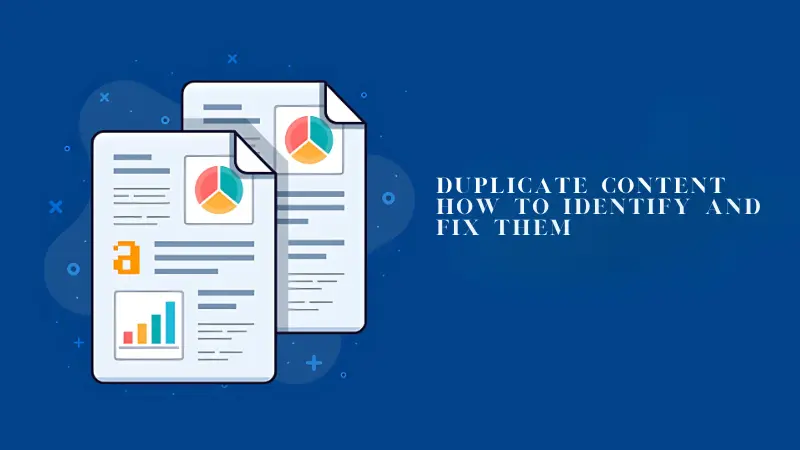Duplicate content is a common SEO issue that can hinder your website’s ability to rank effectively on search engines. Whether it’s accidental or intentional, having the same or similar content across multiple pages can confuse search engines and hurt your rankings. In fact, studies show that websites with significant duplicate content can lose up to 30% of their organic traffic.
But don’t worry—this guide will help you identify, prevent, and fix duplicate content issues to keep your SEO strategy on track.

What is Duplicate Content?
Duplicate content refers to substantial blocks of text that appear across different pages of a single website or between different domains. It doesn’t always mean an exact match—content that is “appreciably similar” can also be considered duplicate.
👉Learn more about improving your content structure in our guide on SEO-Friendly Website Architecture.
Types of Duplicate Content:
Internal Duplicate Content: Occurs when the same content is published on different pages of your website.
External Duplicate Content: Happens when content on your site matches content on other websites.
Near-Duplicate Content: Similar but not identical content across different pages.
Why Duplicate Content is Bad for SEO
While Google doesn’t typically penalize sites for duplicate content, it can cause several SEO challenges:
✅ Keyword Cannibalization:
Multiple pages compete for the same keywords. Read how to avoid this in our Effective Keyword Research Guide.
✅ Reduced Crawl Efficiency:
Search engines waste resources crawling duplicate pages.
👉Learn how to address this with our Crawl Budget Optimization Guide.
✅ Diluted Link Equity:
Backlinks spread across similar pages rather than consolidating authority.
✅ Lower Rankings:
Google may struggle to decide which version to rank.
✅ Bad User Experience:
Users may get confused by repetitive content.
Common Causes of Duplicate Content
Understanding the causes is crucial for fixing and preventing duplicate content issues:
URL Variations:
Tracking parameters or session IDs create different URLs for the same content.
➡️ Learn about best practices in our Technical SEO Checklist.WWW vs. Non-WWW Versions:
Both versions are live without proper redirects, causing duplicate versions of the same page.HTTP vs. HTTPS:
Mixed protocol versions without redirection lead to duplication issues. Ensure all URLs consistently redirect to HTTPS.Copied Product Descriptions:
A common issue in ecommerce websites where manufacturers’ descriptions are reused.
➡️ Check our Ecommerce SEO Guide for solutions.Printer-Friendly Pages:
Separate URLs created for print versions can result in unintended duplicate pages. Use canonical tags or noindex meta tags to avoid this.Scraped Content:
Other websites may copy your content without permission, diluting your SEO efforts.
➡️ Read how to strengthen your site authority in Link Building Hacks Nobody Talks About.
How to Identify Duplicate Content
Detecting duplicate content is the first step toward fixing it. Here’s how:
Tools to Use:
Google Search Console: Check the coverage report for duplicate issues.
Siteliner: Scan your site for internal duplicate content.
Copyscape: Find external content that matches yours.
Ahrefs & SEMrush: Detect duplicate pages and keyword cannibalization.
👉 Pro Tip: Regular audits help you catch and fix issues before they harm your SEO. Refer to our SEO Audit Guide for a step-by-step approach.
How to Fix Duplicate Content Issues
Once you’ve identified duplicate content, use these strategies to fix it:
1. Implement 301 Redirects
Redirect duplicate URLs to the original page. This consolidates link equity and improves user experience.
➡️ Learn more in our Redirects for SEO: Everything You Need to Know.
2. Use Canonical Tags
Add rel=canonical tags to signal which version of a page is the preferred one. This helps search engines avoid indexing duplicates.
3. Update Internal Links
Ensure internal links point to the correct version of a page, avoiding confusion for both users and search engines.
➡️ Improve your linking structure with tips from our SEO and Content Marketing Guide.
4. Rewrite Duplicate Content
Create unique content that offers value to users. Avoid copying product descriptions or blog posts from other sources.
➡️ Need content ideas? Check out our guide on SEO-Friendly Product Descriptions.
5. Utilize Meta Robots Tags
Use noindex tags for pages that shouldn’t appear in search results, like printer-friendly versions.
6. Consistent URL Structure
Set URL parameters correctly in Google Search Console to prevent unnecessary variations.
7. Prevent Content Scraping
Use tools like Copyscape to monitor and report unauthorized use of your content.
➡️ Read our article on How to Use AI for SEO to stay ahead of content protection trends.
Frequently Asked Questions (FAQ)
Q1: Can duplicate content result in a Google penalty?
Not usually. Google doesn’t penalize unintentional duplicate content but may de-prioritize it in search rankings.
Q2: How do canonical tags help with duplicate content?
They inform search engines which version of a page should be ranked, consolidating link equity. Learn how to implement them properly in our Technical SEO Checklist.
Q3: Is external duplicate content worse than internal?
Both are harmful, but external duplicates can lead to copyright issues and ranking losses.
Q4: How often should I audit my site for duplicate content?
At least every quarter, or after significant site changes. Use our SEO Audit Guide to conduct effective audits.
Conclusion
Duplicate content can hurt your SEO performance, but it’s manageable with the right strategies. By regularly auditing your website and implementing solutions like 301 redirects, canonical tags, and unique content creation, you can improve your rankings and enhance user experience.
👉 Ready to eliminate duplicate content issues? Get your Free Website Audit now! 🚀
